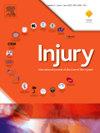儿科患者骨内通路并发骨折 - 系统综述。
IF 2.2
3区 医学
Q3 CRITICAL CARE MEDICINE
Injury-International Journal of the Care of the Injured
Pub Date : 2025-02-01
DOI:10.1016/j.injury.2024.112034
引用次数: 0
摘要
简介:骨内(IO)通路是儿科急诊中常用的一种方法,用于在无法获得其他方法(如静脉内通路)时建立血管通路。与其他途径一样,IO可以快速给药,并在紧急情况下提供药物、血液制品和液体输注的途径。虽然通常认为使用IO是安全的,风险最小,但潜在的并发症可能包括筋膜室综合征、感染、血栓形成和骨折。方法:遵循PRISMA指南,在各种学术数据库中进行全面搜索。搜索参数被限制为排除以下条目:非英文,非全文,在1922年至2022年间未出版。如果文章包括0 - 18岁的患者,并且报告了患者的结果和手术信息,则纳入分析。结果:综合资料(n = 27篇[n = 1339例]),EZ-IO针是主要的获取方式,占69.7%。胫骨是最常选择的植入部位,97%的病例使用了胫骨。在226例报告侧侧性的病例中,观察到左侧(114)和右侧(112)的分布几乎相等。大多数IO尝试在第一次尝试时成功进入血管通道。有23例需要第二次尝试才能进入,4例需要3次或更多次尝试。在1339名参与者中,105例出现并发症,并发症发生率为7.8%。105例并发症中骨折7例(6.67%)。当专门隔离骨折作为导致IO通路的并发症时,仅报告了7例,发生率为0.52%。结论:本综述支持在儿童年龄组使用IO针后骨折作为并发症的罕见性,强调需要进一步的研究来阐明这些病例中与骨折相关的潜在危险因素。此外,该研究还强调了进行进一步病理调查以深入了解骨组织学的重要性,这些组织学可能指示IO通路和/或骨折的发生。本文章由计算机程序翻译,如有差异,请以英文原文为准。
Fractures complicating intraosseous access in pediatric patients – A systematic review
Introduction
Intraosseous (IO) access is a commonly used procedure in pediatric emergencies for establishingvascular access when alternative means, such as intravenous access, cannot be obtained. Likealternative routes, IO can be administered quickly and provides a route for medications, blood products,and fluids to be infused in emergency circumstances. While the use of IO is generally considered safewith minimal risks, potential complications can include compartment syndrome, infection, thrombosis, and fracture.
Methods
Following PRISMA guidelines, a comprehensive search was performed across various academicdatabases. Search parameters were restricted to exclude articles that where; non-English, non-full text,and not published between 1922 and 2022. Articles were included in analysis if they included patients from 0 to 18 and reported on both the patient outcomes and the procedural information.
Results
Following data synthesis (n = 27 articles [n = 1339 cases]), it was observed that the EZ-IO needle was thepredominant choice of access, accounting for 69.7 % of cases. The tibia emerged as the most frequentlyselected insertion site, utilized in 97 % of instances. Among the 226 cases that reported on laterality, a nearly equal distribution between left (114) and right (112) sides were observed. Most IO attempts were successful in accessing vascular access upon first attempt. There were 23 cases that required a second attempt to achieve access, and 4 cases necessitating 3 or more attempts. Within 1339 participants, a complication was reported in 105 cases, producing a complication rate of 7.8 %. Of those 105 complications, fracture occurred 7 times (6.67 %). When specifically isolating fracture as a complication resulting IO access, only 7 cases were reported, indicating an occurrence rate of 0.52 %.
Conclusion
This review supports the rarity of fracture as a complication following the use of an IO needle in pediatric age group, emphasizing the need for additional research to elucidate the underlying risk factors associated with fracture in these cases. Additionally, it underscores the importance of conducting further pathological investigations to gain insight into bone histology that may be indicative of IO access and/or fracture occurrence.
求助全文
通过发布文献求助,成功后即可免费获取论文全文。
去求助
来源期刊
CiteScore
4.00
自引率
8.00%
发文量
699
审稿时长
96 days
期刊介绍:
Injury was founded in 1969 and is an international journal dealing with all aspects of trauma care and accident surgery. Our primary aim is to facilitate the exchange of ideas, techniques and information among all members of the trauma team.

 求助内容:
求助内容: 应助结果提醒方式:
应助结果提醒方式:


